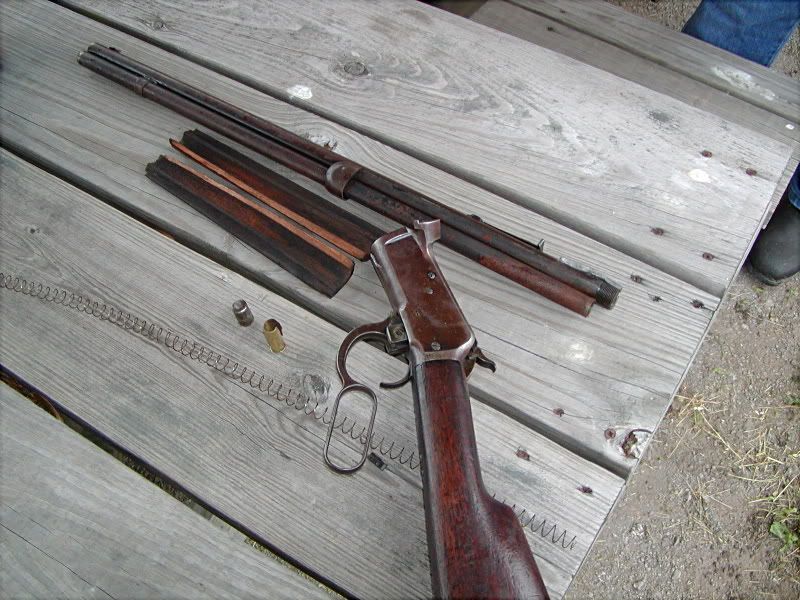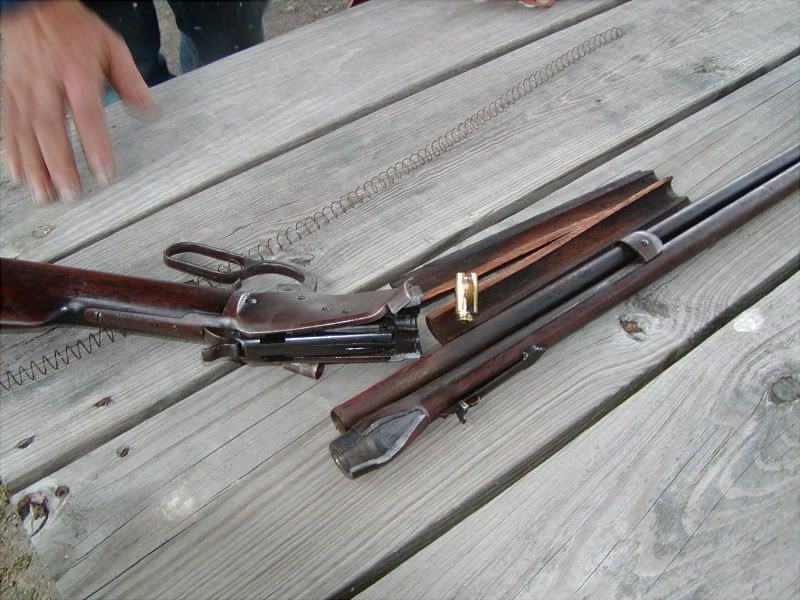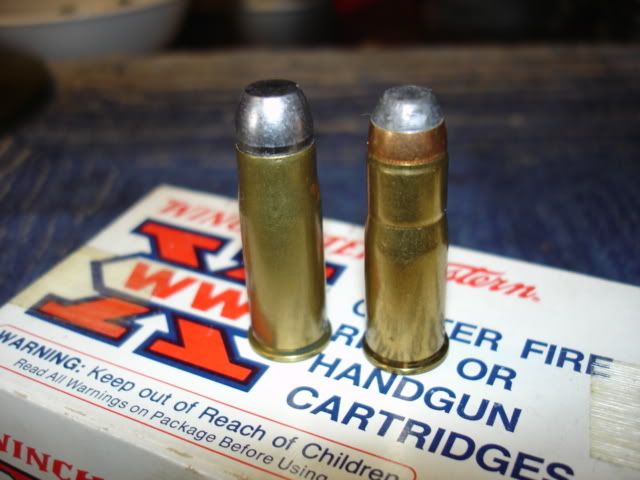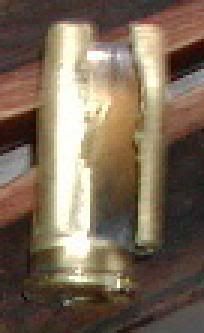Here's the pics of the damaged rifle and brass:



So, whadya'll think?




Thanky kindly fer the warm welcome there, Griff. Can't say I remembers our little debate either - but it's always a pleasure ta' banter back and forth with ya'. .Especially if I ever finally manages ta' get yer goat.Griff wrote:Presidio,
I don't see how you'd "overstay your welcome", Welcome to THE Forum. I seem to recall we "agreed to disagree", don't remember the subject, but do remember I respected your opinion and would welcome your input on any subject.
Could be a double bullet, or just the result of the bullet slipping the crimp, and being shoved down in the case. In either instance, the 38-40 makes missing it an easy miss. Those who reload the 38-40 know that reloaded 38-40 rounds differ a bit from factory loads. Winchester factory 38WCF rounds are a pronounce bottle neck, with a cannelure at the base of the bullet. Here is a pic to show the comparison. Factory round is on the right. Note cannelure at the base of the bullet.Griff wrote:One of the things that occurred to me after dinner last nite was... being as a .38-40 is a bottlenecked case, what would have happened if a bullet was jammed back in the case, then slightly twisted, jamming itself into the neck. That would act as an obstruction without a second projectile and if a higher than normal dosage of powder was present it would certainly exhibit such a catastrophic failure.



Thanks, AJ - knew I was missing something there. I sure weren't arguing the point - jest being curious. And, heck yeah! I even done went and cleaned my dies on my single stage turret press.adirondakjack wrote:Presidio, if you look at the brass at a little less magnification, you can see the gray area near the case mouth appears to be lead smear, it's just shiney gray, almost like somebody dipped it in molton lead, whereas the scorch down in the bottom is definitely a burn mark.
I'm still convinced it was a double balled case (as was Steve Young)
A double balled BOTTLENECK, low pressure case like .38-40 would be a serious bomb when the candle was lit. The charge, probably compressed, would instantaneously ramp pressures waaay out of sight. The bottom bullet would obdurate to fit the chamber BEHIND THE BOTTLENECK, effectively creating a solid obstruction larger than the chamber throat (like a cork stoppering a bottle from the inside) for a few microseconds, as the powder's progressive burn went totally postal because the bullet didnt' move the heck out of the way, until at some point, as the chamber bulged, that obdurated fat bullet, and the one in front of it, finally squirt forth, perhaps mostly as lead or vaper, when the chamber vented to the side. In other words, because the chamber is tapered, the resultant "plug" may have been so tight that the bullets simply vaporized as all he77 broke loose.
PM returned.Mike Hunter wrote:Ranger Clay
Sent you a PM
Mike Hunter
A small charge of smokeless powder resulting in explosive detonation is a reoccurring problem. I teach advanced explosives to some military members and curtain types of smokeless powders can be used as high explosive under the correct circumstances. One of the reasons I don’t load light charges in my toys.Pop Watts wrote:Just one more thought to put into the mix - who knows anything about "secondary explosive effect"?
In theory it can be caused in cartridges loaded with light charges of smokeless powder. The primer flash does not ignite the powder column instantly because it is lying on the bottom of the case. The primer flash however has enough force to move the projectile foward into the lands of the barrel and then it jams there. Now the powder column burns in an increased space caused by the foward movement of the projectile - which is now stationary and jammed into the lands of the barrel. The result is an explosion rather than ignition of the powder and pressures can reach extreme peaks. All of this happens in an instant of time.
I would like to put this theory up for discussion.
There is reason to be cautious about using too light a smokeless powder load in these old black powder cartridges and many reloaders will use wadding to keep the small powder column pushed against the primer flash hole to get consistent ignition.
I have over 20 old 1892's and shoot them regually - but those photo's scared me.
Just my thoughts.
Pop
Ummmm, maybe he had it in for the kid?????Out of 200 rounds the kid brought, we found seven with the wrong bullets. Found out later his pa was load'n his 44WCF's the day before he loaded his kids 38WCF's and must have accidently left some of the .427's in the hopper!
In this case, I doubt it was Unique by itself ..... I'm going with a double charge of Unique. That being said, I know that a lot of shooters use Unique, and it is probably perfectly safe, although much easier to have a double charge than a slower powder that fills the case. For cartridges that were originally black powder, I never use a powder faster than 2400. In general, the faster the powder, the sharper the pressure spike for the same velocity. Blue Dot gives approximately the same pressure curve as FFFg and 2400 gives about the same pressure curve as FFg. Powders slower than 2400 actually give lower pressure curves than black powder for the same velocity (contrary to urban myth) and powders faster than 2400 give higher pressure curves. The faster the powder, the sharper the spike. Here is an example of some pressure curves that illustrate the point ....TNBigBore wrote:Seeing those photos has me a little concerned. I have a first year 1892 38WCF and have been shooting 180 grain jacketed bullets over 10 grains of Unique for my hunting load. It makes a noticeably bigger boom, but I thought this was a safe load even with the older steel of my barrel. Am I off base here?

